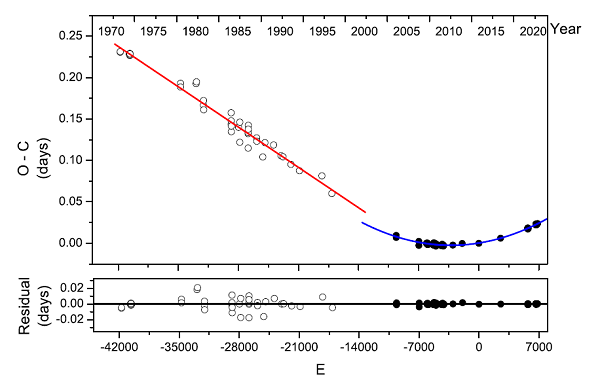In a research paper published recently in the Monthly Notices of the Royal Astronomical Society, Dr. ZHOU Xiao from Yunnan Observatories of Chinese Academy of Sciences, reported a new type of orbital period variations in a close binary system V752 Centaurus.
The observations on close binaries have a long history. However, the formation and evolution of close binaries are still open issues. The investigation of orbital period changes on close binaries will reveal the dynamic interactions in binary systems.
Dr. ZHOU Xiao and his cooperators monitored a very special target V752 Centaurus with the 0.60-m Helen Sawyer Hogg (HSH) Telescope in Argentina to get the multi-color light curves and times of light minimum, and reported that V752 Cen is a W-subtype totally eclipsed binary.
Its period remained constant from the first measurement in 1971 until the year 2000 (red line in Fig. 1), which means there was no mass transfer between the two-component stars during that time interval.
However, the period changed suddenly around the year 2000 and has been increasing continuously since then (blue line in Fig. 1), which can be explained by mass transfer from the less massive component star to the more massive one.
Period variations commonly appear in close binary systems, due to the possible mass transfer between their component stars, angular momentum loss from the binary systems, or perturbation by a third body (light travel time effect).
V752 Cen is a triple-lined spectroscopic quadruple system, and the tertiary and fourth components may make up a faraway binary system. The period variation of V752 Cen over the nearly half century is really unusual, and is potentially related to effects from the possible presence of a nearby third star or of a pair of stars in a second binary. Hierarchical close binary systems are probably common and the far away components may remove angular momentum from central binaries and result in tidal tightening of inner binaries.
However, no observational evidence on dynamic interactions between inner binaries and additional companions was reported. In that respect, V752 Cen is a very interesting hierarchical close binary system with significant research value. The research on its light curves and period variations suggests that dynamic interactions may have happened between the inner binary and companion stars orbiting it.

Fig.1 Period variations of close binary V752 Centaurus (Image by ZHOU Xiao)
contact
ZHOU Xiao, YNAO, CAS
zhouxiaophy@ynao.ac.cn